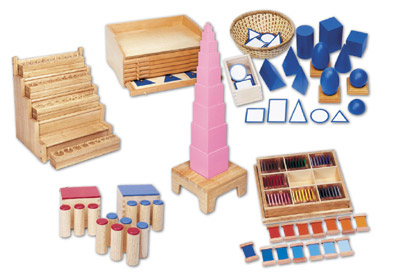Montessori’s materials for the Sensorial work came from her own observations and from ideas and materials from the French doctors Itard and Seguin.
Unlike the material used for Practical Life, this material has either never been seen or never been used by the child in his everyday life.

source: http://www.sihirlibahce.com.tr/wp-content/uploads/2011/10/araclar2.jpg
With this said however, the child will receive no new experiences through the use of the material. This was purposefully thought through in order to give the child what he knows, but might not yet realize, and to then refine his knowledge.
In order to do this, the material is presented in a specific way or in a specific pattern: the child learns to match the similar things, then he is shown how to grade the material based on its quality, and then he receives the language related to his work.

Source: https://i0.wp.com/inlyinsights.org/wp-content/uploads/2019/01/Pink-tower.jpg?fit=1250%2C583&ssl=1
Presenting the material to the child in this way allows him to fully understand the concept of his work.
All of the Sensorial materials were designed keeping the same ideas in mind.
Montessori saw the importance of the manipulation of objects to aid the child in better understanding his environment. Through the child’s work with Sensorial material, the child is helped to make abstractions, he is helped in making distinctions in his environment, and the child is given the knowledge not through word of mouth, but through his own experience.
In Montessori settings exploration using all the senses provides the starting point of the early years curriculum. Practical life and sensorial activities offer young children opportunities to develop manipulative skills and eye-hand coordination as well as problem-solving and thinking skills. This early independence and exploration are the foundation for creative thinking as well as the basis for later more academic work
Additional Resources for reading
9 sense in montessori
https://montessori-school.ca/blog/nine-senses/
5 ways Montessori Appeals to the senses
https://hollismontessori.org/blog/2019/3/26/5-ways-montessori-appeals-to-the-senses
Montessori Sensorial Materials
https://www.kingsley.org/montessori-sensorial-materials
https://montessori-academy.com/blog/sensorial-learning/
In the next few sessions we will see how to use these materials effectively in the classroom.


